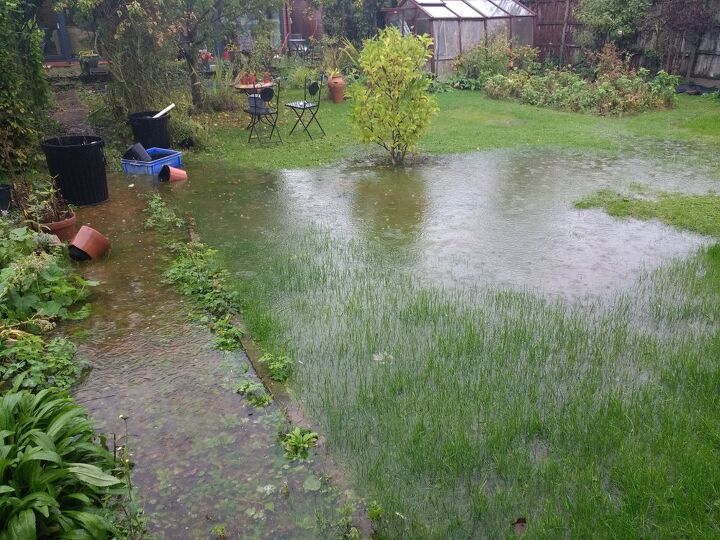How To Revive Plants After A Flood

Flooding events can happen out of nowhere. Major storms have become increasingly common, and they are intensifying faster than ever. Once you survive a flood, your first instinct is most likely to make sure your home and your belongings are safe and secure. It is also important you take a look outside, as flooding can also destroy your garden and many of your outdoor plants. This is especially true if you don’t take steps after a flood to ensure your plants’ survival.
If your plants were flooded, assess the situation and try to facilitate drainage where you can. Allow the plants plenty of time to dry before watering or pruning them. As the soil dries, slowly add nutrients in the form of fertilizer, and replenish displaced soil. Clean dirty leaves and remove dead plants from your garden. Seek the help of a professional if the flood waters are contaminated.
It is important to remember that a flood can not only damage your home, but it can also destroy your outdoor areas, including your plants. This is especially true if you have a flooding event that lasts for many days. The good news is that there are ways to help keep your struggling plants alive after a flood.
Keep reading to learn the many ways to revive your plants after a flood, as well as key safety tips you should be aware of.
Factors To Consider When Reviving Plants After A Flood
The Elevation Of Your Garden
Flooding is likely to affect different parts of your yard in varying ways based on the elevation (or lack thereof) of the yard. If you live on a slope, then you will likely experience a lot of runoff. This can cause a loss of soil and nutrients, but it won’t cause the waterlogging you would experience if you live in a low-lying area or a flood zone.
How Long The Plants Were Submerged
The length of the flooding event is also a major factor to consider. A flash flood might submerge your plants, but it will likely pass quickly. Flooding for days or weeks, on the other hand, requires a very different approach.
Is The Flood Water Toxic?
Sometimes extreme flooding, especially during a hurricane or other form of natural disaster, can involve contaminated water. This happens when the sewage supply is compromised and finds its way into the flood waters. If this occurs, you might need to seek a professional to help remove this toxic waste and water to ensure safety for your family.
Soil And Drainage Type
The type of soil you have, as well as the draining you do or do not have in place, will also have an impact on if your plants can survive a flood easily. If you have a great drainage setup and soil that drains easily, then you might not have to worry too much after a flood.
The Type Of Plants That Were Flooded
Some plants thrive in very wet conditions, and might even welcome a flooding event. Other plants are very sensitive to water levels and might begin to rot and die within days if not properly handled after a flood.
Eight Ways To Help Revive Plants After Your Garden Floods
1. Inspect And Survey The Damage
The first step to reviving your plants after a flood is to inspect the type of damage you are dealing with. Floods can cause a wide range of damage to plants, depending on their length and intensity.
Take a walk through your yard to see what plants are underwater, and what parts of your garden were hurt most by the flood. See if there is any fallen debris or plants with exposed roots. This will give you a good idea about the types of materials you will need to revive the plants.
2. Let The Soil Dry
Patience is crucial when it comes to reviving plants after a flood. Many plants, especially those indigenous to your region, can handle the varying weather conditions, especially if they are well-rooted. The key is to not interfere and to let the soil dry.
Remember that even once the ground feels firm and is no longer wet, the soil underneath may still be waterlogged. Wait until the soil under the ground is dry before you resume your watering routine. Otherwise, you might risk rotting the roots of your plant or drowning it.
3. Don’t Rush To Prune Your Plants
After a flood, you might notice some sagging branches or overgrown branches. It is important to resist the urge to prune your plants after a flood. Most plants are still in recovery mode after a severe weather event. While pruning helps plants when they are healthy, it can shock and sometimes even kill them if they are in recovery mode.
4. Remove Dead Plants And Roots
While it is possible to revive many of your plants after a flood, there is a chance that some of your plants will perish. If you notice dead plants as your garden dries out, remove them. Removing dead plants allows the ones that are still alive more access to nutrient-rich soil, and allows them more space to grow in the sunlight.
5. Slowly Replace Nutrients
As the soil begins to dry, you might need to start adding nutrients. Flood waters can wash away a lot of the nutrients your plants need to thrive. It is important, however, that you don’t overwhelm your plants right after the flood.
Allow them time to dry out, and then slowly introduce fertilizer. If you introduce strong or large amounts of fertilizer, you can shock and harm your struggling plants. Slow and incremental feedings are the key to successfully reviving flooded plants.
6. Try To Facilitate Drainage
After a flood, there is a good chance your drainage systems are overworked, clogged, or both. As you inspect your yard and garden areas, pay particular attention to the drainage. See if you can create additional drainage and repair the existing systems you have in place. You might even want to create a temporary drainage for areas that are under water, to help your waterlogged plants dry out faster.
7. Replenish Soil As Needed
Flooding can cause soil runoff. This can leave your plants without enough soil, and even leave their roots exposed. If you notice soil missing from your garden beds, or anywhere where you have plants, make sure to replenish it. This will protect the roots and allow your plants stability as they recover.
8. Clean Dirt Off The Leaves
If your plants are submerged, they may re-emerge covered in mud. While you don’t want to water your plants when the soil is still wet, you don’t want the leaves to be dirty. Try wiping and misting the leaves until the dirt is removed. This will allow them to use photosynthesis more easily to get nutrients from the sun.
Safety Tips To Know When Gardening After A Flood
Flooding is often the byproduct of a larger natural disaster. If you experienced severe flooding, there are some safety precautions you need to take as you attempt to revive your plants. Below are a few easy but important things you can do to stay safe as you attempt to revive plants after a flood.
- Wear Protective Clothing: Floods can bring lots of sharp and pointed objects and unsafe debris into your yard. Make sure you wear thick boots, protective gloves, and long pants when you work in your garden after a flood.
- Don’t Walk Where It’s Still Flooded: You must wait until the water has receded before you start working in your garden after a flood. It’s fine to work on drainage and assess damage, but allow the ground to harden before working.
- Beware Of Contaminated Soil: One major safety concern to consider is toxic and contaminated water. Listen closely to news reports and notices from your municipality about potential sewage and toxic waste leaks during a flood. Consult a professional for help if you fear your soil is contaminated.
Summing Up How To Revive Plants After A Flood
There is a lot of work to do after a flood. Once you secure the inside of your home, you should inspect the outside to see if it is possible to revive some of your flooded plants. Do your best to help drain flooded areas, and allow them plenty of time to dry. Clean off dirty plants and remove dead ones. Remember to replenish the soil, and slowly add nutrients to the soil to replace those that were washed away.
Related Guides:

Tom Gaffey is an expert writer who currently resides in Washington D.C. Tom has a passion for real estate and home improvement writing, as well as travel and lifestyle writing. He lived the last twelve years in Hawaii where he worked closely with luxury resorts and event planners, mastering his knowledge of aesthetics and luxury products. This is where he found his passion for home improvement and a keen interest in DIY projects. Currently, Tom resides in Washington D.C, and also working on his debut fiction novel.
More by Tom Gaffey














![10 Best Scroll Saws for 2022 [Ultimate Reviews & Buyer's Guide]](https://cdn-fastly.upgradedhome.com/media/2023/07/31/9070684/10-best-scroll-saws-for-2022-ultimate-reviews-buyer-s-guide.jpg?size=350x220)












